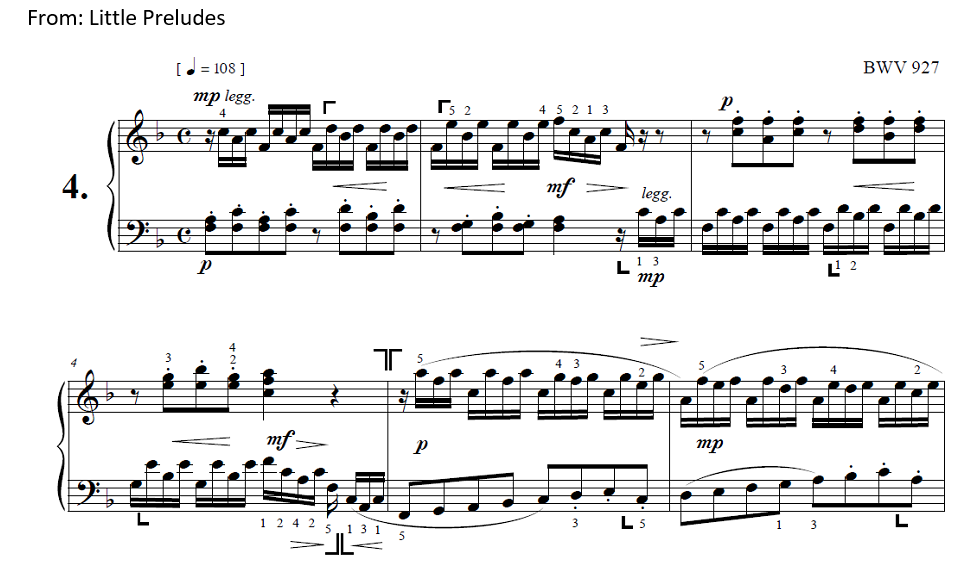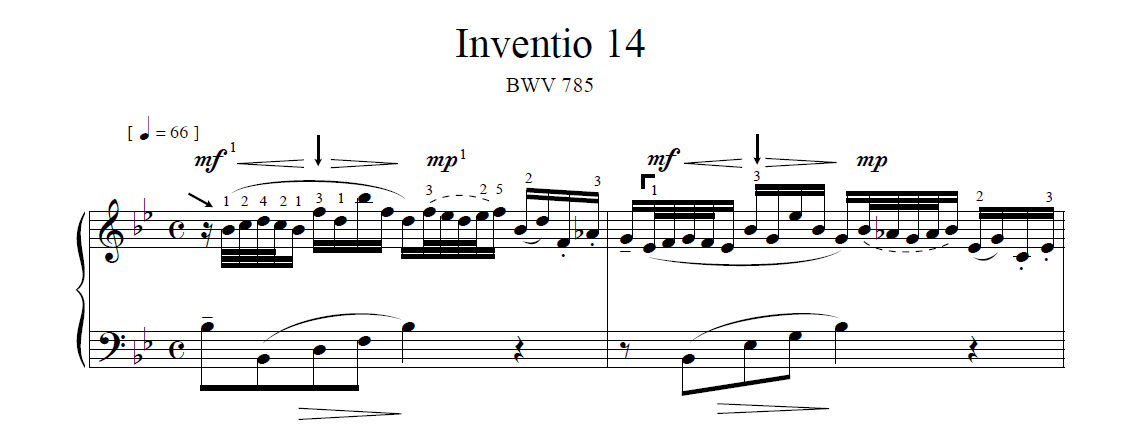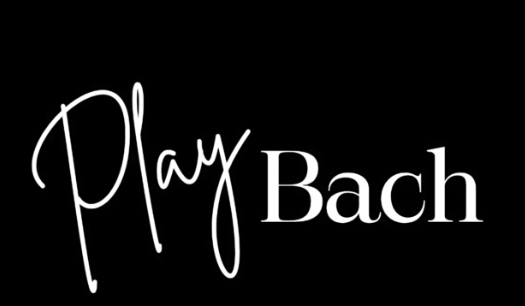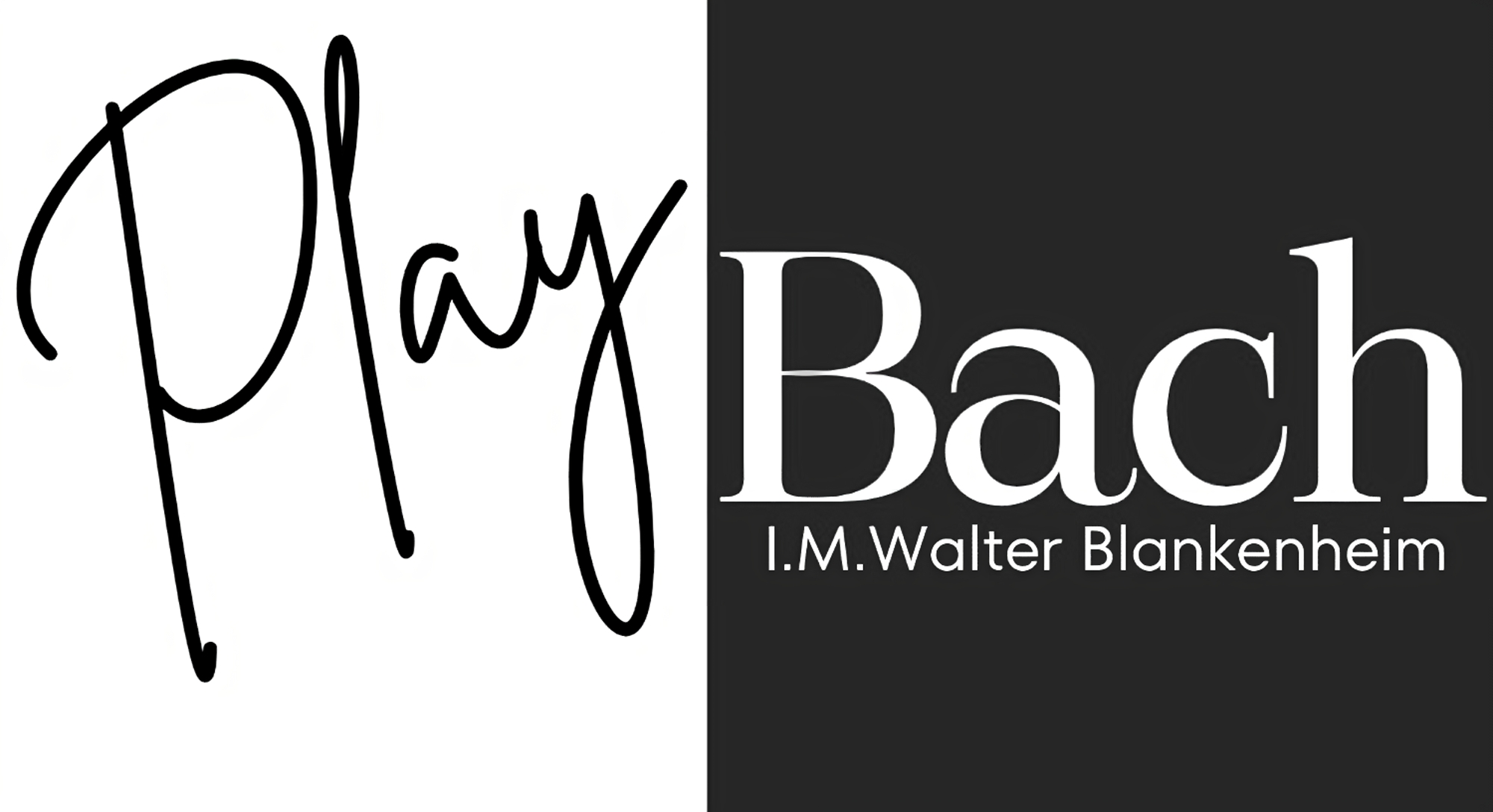We hope that this edition will take some of the hard work out of the process of learning and practicing these works, and more importantly, bring joy and encourage students to become better acquainted with the music of J. S. Bach. May it also give young musicians ideas on how to develop their own interpretations through this interaction with Bach’s works on a creative level.
Kirill Monorosi (Sydney, Australia) and Inge Rosar (Saarbrücken, Germany) March 2021
成绩公布者 La Folia ©
Canon on the Goldberg Ground
Canon on the Goldberg Ground 1a und 1b – La Folia © Score
Canon on the Goldberg Ground 2a und 2b – La Folia © Score
Canon on the Goldberg Ground 3 und 4 – La Folia © Score
Other Canons
Canon in C major version a, BWV 1075 – La Folia © Score (a and b)
Canon in C major version b, BWV 1075
Notebook for Anna Magdalena Bach
C. Petzold: Menuet G major from the Anna Magdalena Bach Notebook, BWV Anh. 114
La Folia © Score
C. Petzold: Minuet from the Anna Magdalena Bach Notebook, BWV Anh. 115
La Folia © Score
J. S. Bach: Minuet in G major from the Anna Magdalena Bach Notebook, BWV Anh.116
La Folia © Score
C. P. E. Bach: March from the Anna Magdalena Bach Notebook, BWV Anh. 122
La Folia © Score
J. S. Bach: Musette in D major from the Anna Magdalena Bach Notebook, BWV Anh. 126
La Folia © Score
J. S. Bach: Aria from the Anna Magdalena Bach Notebook, BWV Anh. 515
La Folia © Score
Schaff’s mit mir Gott from the Anna Magdalena Bach Notebook, BWV Anh. 514
La Folia © Score
Little Preludes
C minor BWV 924 – La Folia © Score
C major BWV 933 – La Folia © Score
C major BWV 939 – La Folia © Score
G minor BWV 929 – La Folia © Score
D minor BWV 926 – La Folia © Score
F major BWV 927 – La Folia © Score
F major BWV 928 – La Folia © Score
C minor BWV 999 – La Folia © Score
Six Little Preludes BWV 939–943+999 C minor
La Folia © Score
French Suites
Minuet I and Minuet II from the French Suite I in D minor BWV 812
La Folia © Score
Minuet I and Minuet II from the French Suite 2 in C minor BWV 813
La Folia © Score
Minuet and Trio from the French Suite 3 BWV 814 –
La Folia © Score
Inventions
Invention No. 1 in C major BWV 772 – La Folia © Score
Invention No. 3 in D major BWV 774 – La Folia © Score
Invention No. 5 in E-flat major BWV 776 – La Folia © Score
Invention No. 6 in E major BWV 777 – La Folia © Score
Invention No. 7 in E minor BWV 778 – La Folia © Score
Invention No. 8 in F major BWV 779 – La Folia © Score
Invention No. 9 in F minor BWV 780 – La Folia © Score
Invention No. 10 in G major BWV 781 – La Folia © Score
Invention No. 11 in G minor BWV 782 – La Folia © Score
Invention No. 14 in B-flat major BWV785 – La Folia © Score
Invention No. 15 in B minor BWV 786 – La Folia © Score
Sinfonias
No. 5 in E-flat major, BWV 791 – La Folia © Score
No. 11 in G minor, BWV 797 – La Folia © Score
No. 14 in B major, BWV 800 – La Folia © Score
No. 15 in B minor, BWV 801 – La Folia © Score
Chorale
Schaff’s mit mir Gott from the Anna Magdalena Bach Notebook, BWV Anh. 514
La Folia © Score
Gottes Sohn ist kommen, (2-part version) BWV 318
La Folia © Score
Erschienen ist der herrliche Tag, (2-part version) BWV 145/5
La Folia © Score
Jesu, meine Freude, (2-part version) BWV 64/8
La Folia © Score
Liebster Jesu, wir sind hier, (2-part version) BWV 731
La Folia © Score
Nun komm, der Heiden Heiland, (2-part version) BWV 62/6
La Folia © Score
Ich ruf zu Dir, Herr Jesu Christ, (2-part version) BWV 1124
La Folia © Score
In dulci jubilo, (2-part version) BWV 368
La Folia © Score
Single works by J.S. Bach
Fantasia in A minor BWV 922
La Folia © Score
J.S. Bach – A.Siloti
Prelude from the Cello Suite No. 1 – La Folia © Score
Courante from the Cello Suite No. 1 – La Folia © Score
Bourrée I + II from the Cello Suite No. 3 – La Folia © Score
Methode ou Recueil – Andante in A minor No. 21 – La Folia © Score
Methode ou Recueil – Prelude in A minor No. 48 – La Folia © Score
Methode ou Recueil – Toccata No. 68
(sometimes 69. It is called Toccata!) – La Folia © Score
Suite No. 1 in C major Prelude – La Folia © Score
Vite in D major, TWV 33:16/3 – La Folia © Score
Lento TWV 33:9/2 – La Folia © Score
Gigue al’ Anglaise (Der getreue Musik-Meister) – La Folia © Score
Sonata in D minor K. 32 – La Folia © Score
Sonata in D minor K. 90 – La Folia © Score
Sonata in C major K. 95 – La Folia © Score
Chaconne in D major (Theme and Variations) –La Folia © Score
Minuet en Rondeau in C major – La Folia © Score
Andante from the Sonata No. 10 – La Folia © Score
J. W. Hässler
– From: 360 Preludes Op. 4
Prelude 6 in D and Prelude 11 in B-minor – La Folia © Score
Prelude 6 in G major and Prelude 11 in E minor – La Folia © Score
Prelude 11 in F major and Prelude 5 in D minor – La Folia © Score
Preludes 5 in B-flat Major and Prelude 4 in G minor – La Folia © Score
本谱使用说明
每项均已标示在此曲谱里(并不意味每部作品都涵盖以下所有要素,详情请参考对应作品):
- 乐曲的速度
- 结构与乐句
- 运音法与不同音符的作用
- 力度与力度变化的设计
- 装饰音
- 踏板的运用
- 指法与双手的安排
- 结构与乐句
结构在巴洛克音乐晚期,特别是巴赫的作品里占据着至关重要的地位。其他的音乐元素,如分句,触键,
以及力度变化等等都做为辅助条件用来衬托结构在当时作品中的重要性。
此记号指出弱起拍音符以及一个新乐句的开端:
![]()
此记号标出新的段落:
![]()
此记号标出主题进行:
![]()
- 运音法以及音符的作用
虽然巴赫在他的康塔塔,受难曲,和协奏曲中交响乐部分以及声乐部分给出了运音标识,然而他在他的独奏键盘作品中却几乎从未标出,导致演奏者在研究他的作品时往往在运音法上受挫,有无数种可能性的运音方式反而给演奏者形成了障碍。
同时,在他的手稿中,已标出的运音记号很大程度上缺乏精确度且相互矛盾。更令人纠结的是,适合大键琴或羽键琴的运音方式并不一定都适用于现代钢琴。
此版本在选择运音法上的依据在于理解不同情况下每个音符所发挥的不同作用。例如作为旋律线或和声里的音符;强/弱拍、弱起拍、拍后音;一句旋律的开端,顶点,结尾;以及终止式等等,演奏者须对各种音符的不同作用有清楚的认识,从而塑造出相应的诠释。
- 力度与力度变化的设计
力度可用“结构式”性质(代表阶梯式的力度变化,每一个“阶梯”里又含有自身力度变化的走向)来理解。当演奏者在一个可诠释出丰富表情变化的乐器上演奏,例如现代钢琴,不仅可以通过阶梯式力度变化(例如指定:强“f”,中强“mf”,弱“p”等在相对应的段落)来划分出作品的结构,并且能同时利用内在力度的变化(渐强“crescendo”,渐弱“decrescendo”)起到正确表达每个段落内容的作用,就像沃尔特· 布兰肯海姆提出的“活跃的”(animated line)和“富有生机的”(living line)线条。
- 装饰音
巴赫在他的书中《Clavier-Büchlein vor Wilhelm Friedemann Bach》,列出了他独创的一套装饰音法则表,直到今天此表都作为极为宝贵的参考教材在许多地方均可查阅。然而,这并不代表每个装饰音都一定要无条件遵守此表或按照固定规则弹奏(例如演奏者们都了解的颤音,由相邻上方的音开始),因为一些特定情况下做此处理会导致平行五度或八度的出现。举一个较出名的的例子:在二部创意曲第二首的第3小节,此处的颤音若从相邻上方的音起,就会产生双耳可明显分辨的平行八度。为了避免这种情况,我们建议此颤音由主音起,并且在其它相似的地方用此弹法能够产生迷人的不和谐音程。在三部创意曲第八首中,主旋律(第一次出现在第一小节的中声部)呈现了下行的走向。这里的颤音若是从高音起便会打断这条设计好的旋律线,因此本版建议此颤音也由主音起。
在此版本中,标出的指法可帮助演奏者弹奏装饰音。因此,一个颤音是由高音还是主音起可以从谱中标记的指法看出;为了方便起见,有的指法同时代表了短颤音中所需的音符数量。
- 指法与双手的安排
为了帮助业余演奏者能够更好地达到相应作品里所需的技巧程度,我们把“较强”的手指(1,2,3)与“较弱”的手指(4,5)以更灵活与放松的方式结合。卡尔·菲利普·埃马努埃尔·巴赫(C. P. E巴赫)在他的教学式键盘作品中,特别是《论键盘乐器演奏艺术的真谛Essay on the True Art of Playing Keyboard Instruments》一书中,着重强调了运用合适指法的重要性:“一个普通但指法技术高超的演奏家会击败一个在音乐方面拥有极高造诣,却只能使用平庸的指法技术勉强弹奏的演奏家。”[1]
我们希望此版本能够为学生们在学习和练习此作品时带来乐趣,摆脱一些困扰,
更重要的是鼓励年轻的音乐家们通过解析乐谱去深入了解巴赫的音乐,发挥自身的创造力,
从而找出独特的,属于自己的诠释方式。
基里尔·莫诺罗西(澳大利亚)
与
英格·罗莎(德国)
2021年3月
分数示例:







